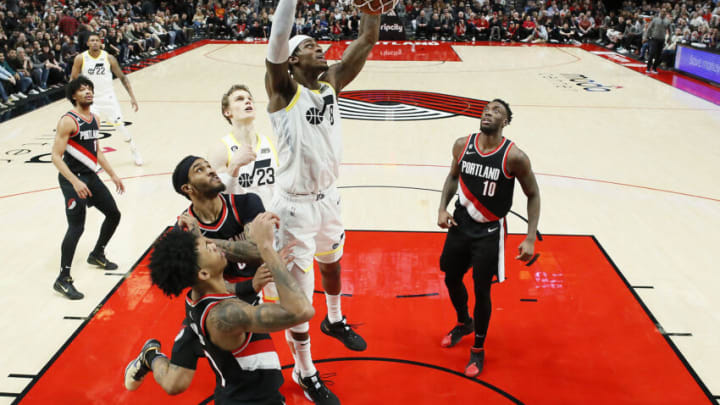The Portland Trail Blazers have emerged as “strong suitors” for Utah Jazz forward Jarred Vanderbilt, according to Shams Charania of The Athletic.
Western Conference playoff contender emerges as strong suitor for Utah’s Jarred Vanderbilt: pic.twitter.com/WMzNyGEVzS
— Shams Charania (@ShamsCharania) February 2, 2023
In his seemingly never-ending quest to re-tool the roster around Damian Lillard rather than rebuild it, Blazers general manager Joe Cronin is apparently dipping his toes into the marginal-move pool heading toward this year’s Feb. 9 NBA trade deadline.
On the surface, yes, dealing for Vanderbilt seems like a small trade for a simple rotation-caliber player.
But the 23-year-old would be a more significant move for Portland. His athleticism, length, and versatility could give the Blazers and head coach Chauncey Billups a lineup made for the postseason.
Jarred Vanderbilt could be the key to unlocking the Portland Trail Blazers’ ideal rotation
The sample size is large enough at this point to be pretty certain that Jusuf Nurkic is no longer the right fit at center for the Blazers. He’s too slow, too unathletic, and his effort disappears far too often.
Billups’ lineup seems to be at its best when he goes small. The current problem is that small means really small, as Nurkic’s backup, Drew Eubanks, is a towering 6-foot-9.
But the stats prove the Blazers are at their best when their starting center plants his plodding feet on the pine.
Four different five-man lineups have played in at least nine games together this season for Portland. The only two that are positive in terms of plus-minus involve Eubanks, not Nurkic.
In terms of on/off statistics, Portland is better both offensively and defensively with Eubanks on the floor. The Blazers do score 2.6 points per game more with Nurkic on the court, but a simple eye test proves everything just flows better with a center that can move.
Nurkic played only two minutes of Portland’s critical road win in Memphis on Feb. 2 because of a calf injury. A combination of Eubanks and Trendon Watford filled in at the five. To add injury to injury, Jerami Grant also missed the entire second half in concussion protocol.
That night, the five-man lineup of Lillard, Gary Payton II, Nassir Little, Shaedon Sharpe, and Watford completely blitzed the Grizzlies. That group scored 23 points in less than nine minutes, nine of which came off turnovers. They shot 50 percent from the floor (7 of 14) and got to the free-throw line seven times.
An extremely small sample size to be sure, but one that shows the kind of rotation that fits best around Dame.
Enter Vanderbilt.
Alongside Lillard in that lineup were Payton II, a pure lockdown defender; Little, a 6-6 ball of muscle with a 7-2 wingspan; Sharpe, a raw but uber-athletic shot creator with his own 7-foot wingspan; and Watford, a sturdy 6-8 forward who was perfectly content shooting six times in 22 minutes.
What that lineup lacks is height; what it doesn’t lack is length, athleticism, or energy. You know what else doesn’t lack length, athleticism, or energy? Jarred Vanderbilt.
Vanderbilt is 6-8 with a 7-1 wingspan and has per-36 minute averages of 12.6 points and 11.6 rebounds this season in Utah. He has a similar body type and similar athleticism to Grant, just without the offensive skillset.
But because of that, he doesn’t need the ball to be effective. Watford took six shots against Memphis – Vanderbilt is averaging 6.1 shot attempts per game this year.
So imagine a long, lanky, explosive athlete playing those 22 Watford minutes. And imagine a healthy Grant in that lineup. That would make for a dramatic jump in defensive ability and versatility in an already defense-heavy lineup surrounding Dame.
Nurkic and Eubanks are averaging a combined 46.2 minutes this season, basically the equivalent of an entire game’s worth of a center. Vanderbilt is playing 24.2 minutes a night in Utah. Assuming he plays the same number if he ends up in Portland (it could be more), that leaves 20 minutes to split between Nurk and Drew.
The Bosnian Beast might remain the nominal starter in this scenario, but his time on the floor could be cut in half, if not further. Eubanks could lighten his load a bit instead of having to fill in for Nurkic.
Assuming Portland’s starting lineup remains the same – Lillard, Anfernee Simons, Josh Hart, Grant, and Nurkic – the bench rotation would include Payton II, Little, Sharpe, Vanderbilt, and Eubanks. (Not accounting for one or more of these players going back to Utah in the trade).
Billups could theoretically close games with Dame, Simons, and Grant – his team’s three best scorers – alongside two long, athletic, versatile, switchable defenders in Little and Vanderbilt. (In addition to his offense, Jerami also happens to bring length, athleticism, versatility, and switchability).
Rather than Nurk struggling to get up and down the floor, Billups could feature high-level athletes at all five spots on the floor at all times, like he did when that group blew Memphis out of the water for nine minutes. The diminutive backcourt of Lillard and Simons could be protected by any combination of Payton, Little, Hart, Sharpe, Grant, or Vanderbilt.
Bringing in a fourth-year role player wouldn’t make the Blazers title contenders. But the different options Vanderbilt could unlock and the distinctively different style of play he could bring to Dame-centric lineups may open the door, at least a crack, to a postseason run.
